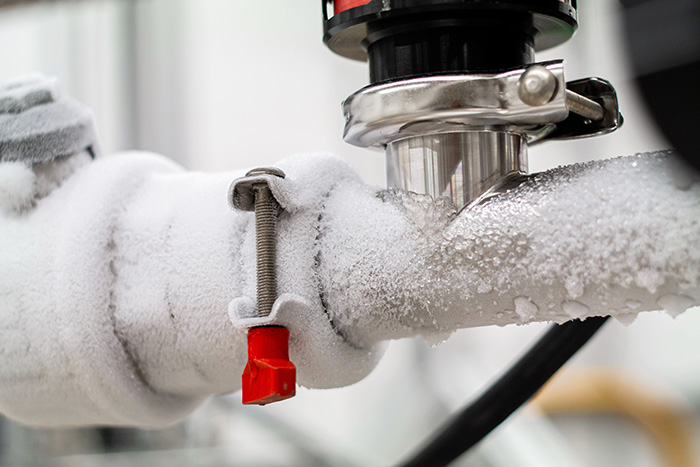What are your thoughts on 6 Ways to Prevent Frozen Pipes?

Winter can damage your plumbing, particularly by freezing pipelines. Right here's just how to prevent it from occurring and what to do if it does.
Introduction
As temperatures decline, the danger of frozen pipelines increases, potentially leading to expensive repairs and water damages. Recognizing exactly how to stop icy pipelines is essential for home owners in chilly environments.
Comprehending Icy Pipes
What causes pipes to ice up?
Pipes ice up when revealed to temperatures listed below 32 ° F (0 ° C) for extended periods. As water inside the pipes freezes, it broadens, taxing the pipe walls and possibly creating them to burst.
Risks and damages
Frozen pipes can cause water disruptions, building damages, and pricey repairs. Burst pipes can flood homes and create considerable structural damage.
Indications of Frozen Pipes
Determining frozen pipelines early can avoid them from bursting.
Exactly how to determine icy pipes
Look for reduced water flow from taps, uncommon odors or sounds from pipelines, and visible frost on revealed pipelines.
Prevention Tips
Insulating prone pipelines
Cover pipelines in insulation sleeves or use warm tape to protect them from freezing temperature levels. Concentrate on pipelines in unheated or external areas of the home.
Heating strategies
Keep interior rooms sufficiently heated up, especially areas with plumbing. Open cabinet doors to permit warm air to circulate around pipelines under sinks.
Safeguarding Outdoor Plumbing
Yard hose pipes and outside taps
Separate and drain yard tubes prior to wintertime. Install frost-proof faucets or cover exterior taps with protected caps.
What to Do If Your Pipes Freeze
Immediate actions to take
If you presume icy pipes, keep faucets available to eliminate pressure as the ice melts. Make use of a hairdryer or towels taken in warm water to thaw pipes gradually.
Long-Term Solutions
Structural adjustments
Consider rerouting pipelines far from outside wall surfaces or unheated locations. Include additional insulation to attics, basements, and crawl spaces.
Updating insulation
Purchase high-quality insulation for pipes, attics, and wall surfaces. Correct insulation aids maintain constant temperature levels and reduces the threat of frozen pipelines.
Verdict
Preventing frozen pipes requires proactive measures and fast reactions. By understanding the reasons, signs, and preventive measures, homeowners can safeguard their pipes during winter.
5 Ways to Prevent Frozen Pipes
Drain Outdoor Faucets and Disconnect Hoses
First, close the shut-off valve that controls the flow of water in the pipe to your outdoor faucet. Then, head outside to disconnect and drain your hose and open the outdoor faucet to allow the water to completely drain out of the line. Turn off the faucet when done. Finally, head back to the shut-off valve and drain the remaining water inside the pipe into a bucket or container. Additionally, if you have a home irrigation system, you should consider hiring an expert to clear the system of water each year.
Insulate Pipes
One of the best and most cost-effective methods for preventing frozen water pipes is to wrap your pipes with insulation. This is especially important for areas in your home that aren’t exposed to heat, such as an attic. We suggest using foam sleeves, which can typically be found at your local hardware store.
Keep Heat Running at 65
Your pipes are located inside your walls, and the temperature there is much colder than the rest of the house. To prevent your pipes from freezing, The Insurance Information Institute suggests that you keep your home heated to at least 65 degrees, even when traveling. You may want to invest in smart devices that can keep an eye on the temperature in your home while you’re away.
Leave Water Dripping
Moving water — even a small trickle — can prevent ice from forming inside your pipes. When freezing temps are imminent, start a drip of water from all faucets that serve exposed pipes. Leaving a few faucets running will also help relieve pressure inside the pipes and help prevent a rupture if the water inside freezes.
Open Cupboard Doors
Warm your kitchen and bathroom pipes by opening cupboards and vanities. You should also leave your interior doors ajar to help warm air circulate evenly throughout your home.

As a keen reader on How to prepare your home plumbing for winter weather, I figured sharing that segment was really useful. Don't hesitate to pause to promote this blog entry if you enjoyed reading it. I am grateful for being here. Revisit us soon.
Free Estimates
Comments on “Avoiding Frozen Plumbing in Winter: Essential Strategies”